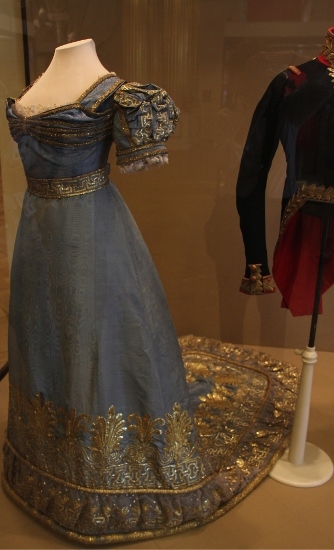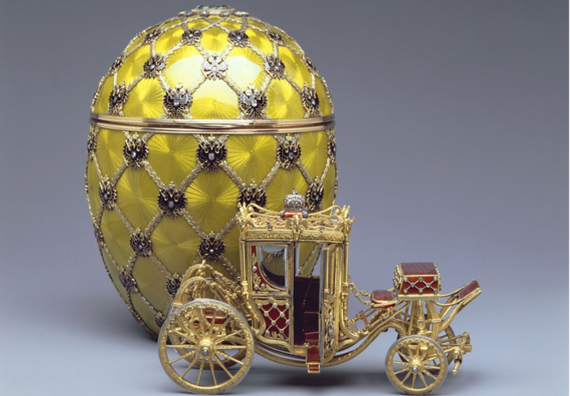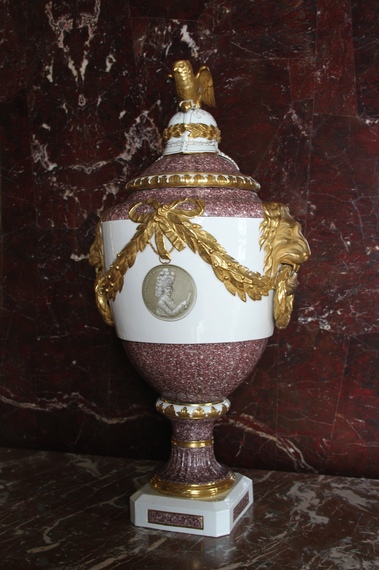In 1764, Russia's art-loving Catherine the Great founded the Hermitage Museum with the first of many paintings acquisitions. This year, to celebrate its 250th anniversary, the Hermitage has organized a visual feast: "At the Russian Imperial Court: Costumes of the 18th - early-20th Centuries" (through October 19, 2014). Splendid clothing fills five halls of the Winter Palace where the Romanovs and their courtiers wore many of the fashions during receptions, balls and official ceremonies.  At the Russian Imperial Court, State Hermitage Museum, photo by Ruth Cousineau
At the Russian Imperial Court, State Hermitage Museum, photo by Ruth Cousineau
From the vast wardrobe closets of the Hermitage, curators plucked sumptuous silk gowns and velvet embroidered suits belonging to members of the imperial family and their inner circle. The show traces the evolution of Russian court taste, style and fashion -- from a uniform tailored for towering 6' 8" Peter the Great to a ball gown of petite Maria Feodorovna, wife of Alexander III.
It was Catherine the Great who established the Russian imperial court as one of Europe's most magnificent. She ordered her ladies-in-waiting to wear gowns replicating the uniforms of Russia's imperial guards. Two of her own blue and green silk military gowns are on display, an elegant fusion of Russian and European styling (http://www.hermitagemuseum.org).
The behind-the-scenes tour of the Hermitage was the first stop on a recent river voyage from St. Petersburg to Moscow via Viking River Cruises which I embarked on this summer to complete research for a book on Catherine the Great. Catherine herself made a cold and windy Volga voyage in April 1767 with a 2,000 person entourage and seven galleys. We enjoyed much better weather, and despite ongoing tensions over Ukraine, were welcomed warmly (http://www.vikingrivercruises.com).
From the Hermitage, it's a short jaunt to the newly opened Fabergé Museum (http://www.fsv.ru). Ten years ago, Russian oil tycoon Viktor Vekselberg bought the Forbes Fabergé collection, including nine imperial Easter eggs, for $100 million. The clutch is now on display inside the restored 18th century neoclassical Shuvalov Palace. A red carpeted grand staircase leads to the gilded and chandeliered Blue Room, where each of the jeweled eggs enjoys its own glass display case.
Coronation Egg, courtesy of the Faberge Museum, St. Petersburg
In 1885, Catherine II's great, great grandson, Alexander III, gave his wife Maria Feodorovna the Hen Egg, a white enameled gem by St. Petersburg jeweler Peter Carl Fabergé. The tsarina was so delighted, Alexander placed nine more orders. His son Nicholas II continued the tradition, commissioning two eggs each year from the House of Fabergé -- one for his mother and another for his wife Alexandra.
Among the museum's showstoppers is the Coronation Egg, inspired by the gold ermine-trimmed robes worn by Nicholas and Alexandra during their coronation ceremony in 1896. Inside the velvet-lined compartment is a tiny gold and diamond replica of the couple's carriage, complete with etched rock crystal windows.
Each year, the eggs became more spectacular as Fabergé strove to please its royal patrons. To mark the 15th anniversary of Nicholas's reign in 1911, court miniaturist Vasily Zuiev covered a white enameled egg with 18 painted scenes -- historical events along with portraits of the royal couple and their five children. Deep green enameled laurel leaves with gold and rose diamond crosses separate the miniatures.
While Alexandra was unwrapping her egg from its velvet and silk case, her mother-in-law was enjoying an equally charming gift -- the topiary-shaped Orange Tree Egg set in a white agate planter. At the touch of a button, the nephrite foliage at the top of the tree popped up, releasing a singing nightingale. Also in the Blue Room are five exquisite eggs Fabergé created for wealthy clients, including Consuelo Vanderbilt, the American heiress who married the Duke of Marlborough, Winston Churchill's cousin (Fabergé lovers can enjoy ten more Easter eggs in Moscow's Kremlin Armory Museum).
Another newly opened St. Petersburg attraction, the Agate Pavilion, is located south of the city in Pushkin, home to popular Catherine Palace (named for Catherine I, second wife of Peter the Great) (http://www.tzar.ru). Catherine the Great made numerous additions to the palace complex, including the Pavilion, "an ancient house with all its décor" connected to her private apartments. Drawing inspiration from a Roman Thermae, Scottish architect Charles Cameron designed a luxurious spa for the Empress with a rich suite of upstairs rooms for relaxing and entertaining. 
The Agate Pavilion beside Catherine Palace, photo by Ruth Cousineau
During the three-year siege of Leningrad, the Pavilion was used as an officer's club by the Nazis. This summer, after detailed renovations, the upstairs rooms reopened to the public. Donning booties, we wound our way up Cameron's refined grey granite spiral staircase capped by a lace-like domed ceiling. The spectacular marquetry floors were designed for a city residence Catherine II was building for her young favorite, Alexander Lanskoy. After Lanskoy's sudden death at 26, the grieving Empress had the floors removed and reinstalled in her new Agate Rooms.
From the intimate library to the vaulted Large Hall, Charles Cameron lined the walls and doors of the rooms from floor to ceiling in jasper mined from the Urals. The luxurious suite became known as the Agate Rooms after the red jasper known as jasper agate in the 18th century. To enhance the color of the semi-precious stones, Cameron had his team of craftsmen grind and polish the jasper walls to a mirror-like sheen. Two of the rooms are finished in handsome dark red Urazovo jasper with quartzite inclusions, known as "meat agate."  Vase, Agate Pavilion, photo by Ruth Cousineau
Vase, Agate Pavilion, photo by Ruth Cousineau
To produce steam for Catherine the Great's bath house, her staff poured water over 250 cannonballs set over the latticed vault of a stove. Courtesy of Charles Cameron, she also enjoyed an unctuarium for the application of oils, an exercise hall, warm room and cold room with a pool.
Intrigued, we signed up for a Russian banya -- a relaxing cross between a Finnish sauna and Turkish bath. A handsome young man named Roman arrived on scene with two bunches of white birch branches which he used on our backs, shoulders and legs -- like a car wash. The finale involved cold buckets of water and an invigorating jump into Lake Ladoga.
Susan Jaques is the author of "A Love for the Beautiful: Discovering America's Hidden Art Museums"
